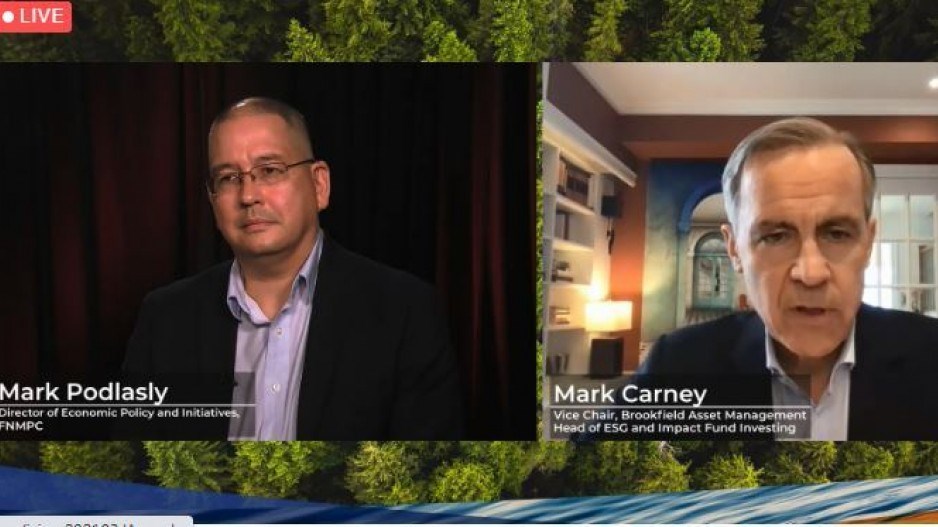Whether it is developing renewable energy – like the Fort Nelson First Nation’s Clarke Lake geothermal energy project – or selling carbon credits for reforestation -- First Nations will play a vital role in sustainable development that has both environmental and economic benefits, says Mark Carney.
Carney, who is the former governor of both the Bank of Canada and the Bank of England, is now vice chairman and head of ESG and impact investment for Brookfield Asset Management, as well as the United Nation’s special envoy on climate action and finance.
He was the keynote speaker Thursday at a two-day virtual Indigenous Sustainable Investment Conference sponsored by the First Nations Major Projects Coalition (FNMPC).
Roughly 1,500 people are attending the two-day conference, many of them investors keen on learning about Canada’s unique investment climate, which necessarily includes the consideration of indigenous rights and interests, especially in energy projects and resource extraction.
First Nations in Canada are increasingly becoming partners and proponents in both traditional resource industries and the growing sustainable energy and resources sectors.
Major projects that are moving forward in Canada – from new mines to LNG projects – are doing so in no small part because they have the support of First Nations. It’s perhaps no small coincidence that many of the projects in B.C. that have failed to get environmental approval or economic sanctioning – especially in the mining space – are those that did not have the support of First Nations.
“Projects have not happened,” Carney noted. “Part of the reason that projects have not happened is because there was not that inclusive decision making process from the start. That is something that we need to learn in all our institutions in Canada.”
In Canada, it is becoming increasingly important for investors who may be thinking about deploying capital in Canada to look at the ESG (environmental, social and corporate governance) standards of the companies they may be thinking of investing in.
But a company may tick all the ESG boxes and still not fully understand or address indigenous interests. Mark Podlasly, director of economic policy for the FNMPC, pointed out that, while aggregated ESG standards may mention indigenous rights and opportunities – and may even reference the United Nations Declaration on the Rights of Indigenous People (UNDRIP) -- none of those standards were developed with the input of indigenous people.
These standards therefore lack the “Canadian lens” through which investors can look to determine if a project or company is likely to have First Nations as allies or foes.
“ESG standards, for the most part, have been developed outside of Canada,” Podlasly said. “So if a company, an investor, looking to invest in a Canadian company or operation is wanting to place capital, have they adequately taken into account the indigenous concerns and rights…in the Canadian context?”
Carney said the international financial system is beginning to factor in climate change risks. New sustainability reporting standards are still being developed for the International Financial Reporting Standards (IFRS). He said they will necessarily need input from indigenous people.
“We’re working on developing new global standards for such sustainability reporting through the IFRS, which governs disclosure standards in 140 countries, including Canada,” he said. “They will start with climate, but then quickly move to broader sustainability issues. The engagement of indigenous communities in those processes will be vital.”
As for opportunities for First Nations in the new sustainable economy, Carney said “natural climate solutions” is one area that is still underdeveloped but which has potential. By natural climate solutions he means natural carbon sinks, like forests and wetlands.
“Protecting and restoring our forests, peatlands and wetlands globally has the potential to provide up to one-third of the reduction of global emissions needed by 2030,” Carney said. “Not only are these natural climate solutions often cheaper than technology based removal, it also can bring broader societal benefits.”
But the carbon sink space has only captured about 3% of the global investment in climate solutions, Carney added.
“We need to rapidly scale them to address the crisis in climate change and biodiversity loss,” he said, adding: “Almost one-quarter of the planet’s land, and three-quarters of the biodiversity on the earth, is located in indigenous territories.
“The full participation of indigenous communities is essential to tackling climate change, to protecting natural assets. It’s one of the reasons why the work of the First Nations Major Projects Coalition is critical.”
As for sustainable development financing for First Nations, Carney suggested carbon offsets as one potential investment vehicle. The carbon offset market is still small, he said – about $300 million a year – and standards are still being developed.
“Properly structured, it could grow quickly to $100 to $150 billion a year,” he said. “It will have the potential to price co-benefits, including biodiversity and economic development, and it can provide enormous opportunities for indigenous communities.”




